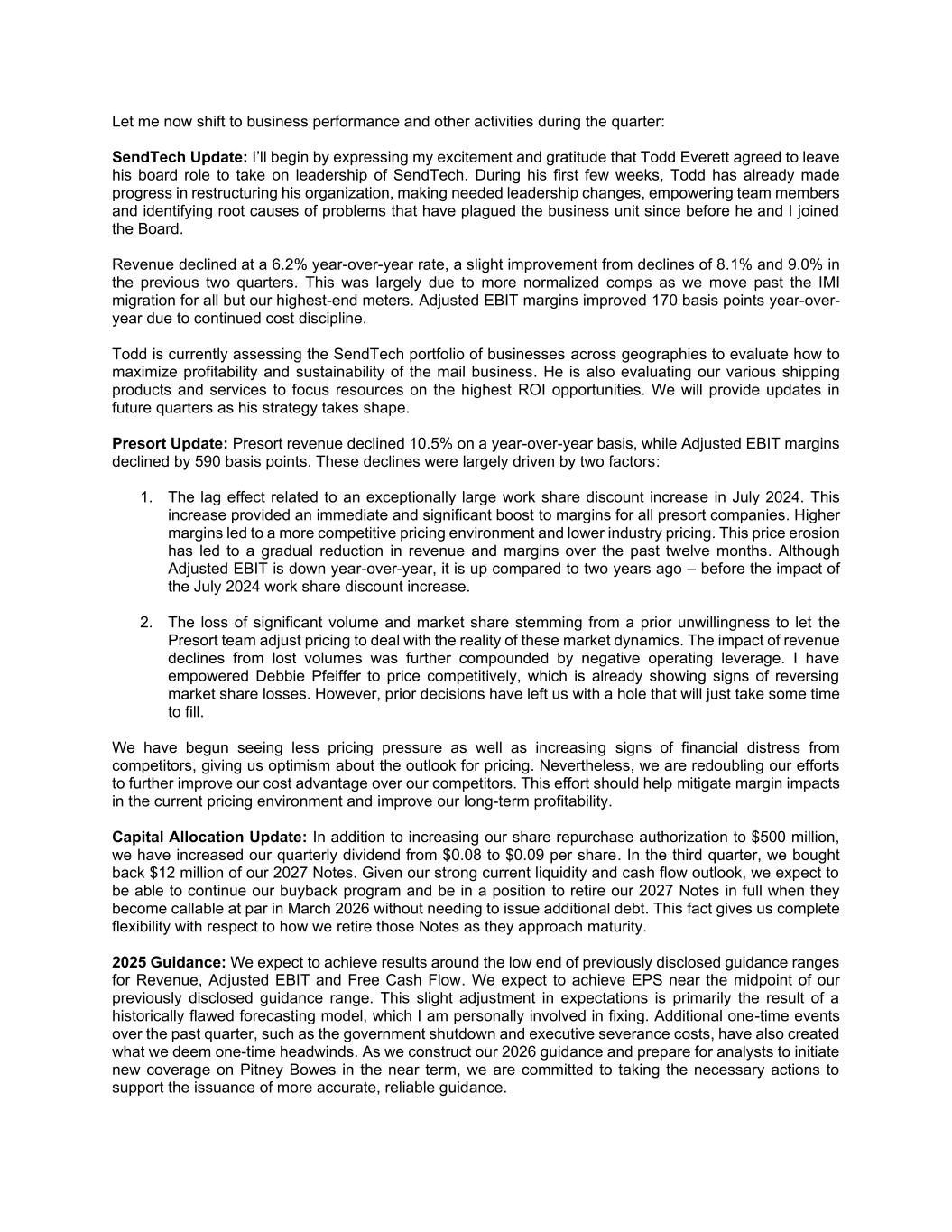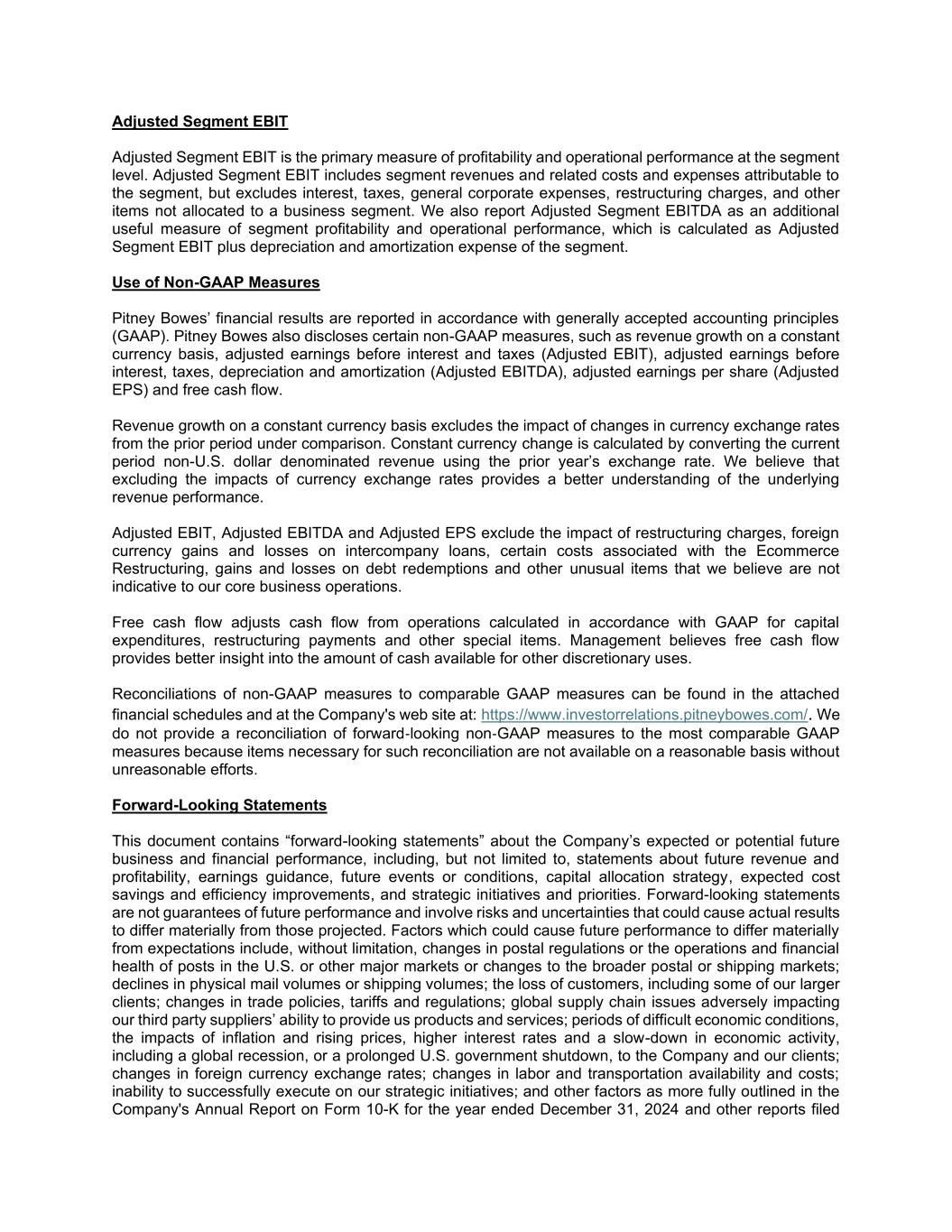
Fellow Shareholders, During the third quarter of 2025, leadership devoted significant time to accelerating the first phase of our strategic review. We were able to continue fixing long-unaddressed issues and start identifying new opportunities for future value creation. Here is a brief overview: 1. Solidifying Our Leadership Team – I recently completed an evaluation of the leadership team, resulting in several additional changes. Over the past five months, we have appointed a new CFO as well as new leaders for SendTech, IT and HR. Each member of our strengthened leadership team has in turn been upgrading their own teams. Achieving our goal of profitable growth will require a different mix of skills and an investment in attracting, developing and retaining top talent. This effort is being pushed down the organization and is enabling us to increasingly rely on internal employees, rather than external consultants, to drive analysis, decision making and execution. 2. Streamlining Our Org Structure – We are nearing completion of our review of our organizational structure, which has led to the realignment of our Global Financial Services (“GFS”) team. It became apparent to me after stepping into my new role that GFS was creating inefficiencies and perpetuating misaligned incentives across the organization. We are currently reassigning roles and responsibilities of GFS employees. Additionally, we are in the process of reorganizing SendTech, Legal, HR and IT to create reporting structures that align with our business needs. 3. Implementing $50 Million to $60 Million in New Cost Cuts – Beyond fixing our structure, we are aggressively streamlining operations in order to improve our ability to quickly make decisions and execute. A silver lining is the elimination of costs. We currently estimate that, in addition to improving operations, the company will eliminate an additional $50 million to $60 million in annual expenses, the vast majority of which should be realized by the end of this year. 4. Sustaining Meaningful Buybacks – We continued to aggressively buy back our stock during the quarter. This was informed by our expectation for continued strong Free Cash Flow, the opportunities we increasingly see for profit improvement and growth and our belief that our stock is significantly undervalued. Through last Friday, we repurchased 25.9 million shares at a total cost of $281.2 million since starting the program earlier this year. In the third quarter alone, we bought back over 8% of the shares outstanding. 5. Mitigating Financial Risk – We have begun “de-risking” the company in areas that aren’t core competencies. For our U.S. and Canadian pensions, we have taken steps to mitigate market risk and are evaluating potential exits. At the PB Bank, we have slowed lending by increasing our risk- adjusted return expectations on third-party loans. Although these changes create short-term financial headwinds, they are part of positioning the company for long-term value creation. 6. Establishing Accurate, Reliable Forecasting – Our work to “drill down to bedrock” continues to identify opportunities to significantly improve our ability to achieve operational excellence across all aspects of the organization. This work is largely being carried out by the executive team members and their organizations. Nevertheless, I have personally involved myself with fixing our forecasting process. As I highlighted throughout 2022 and 2023, Pitney Bowes has a long history of missing guidance, and I am working with Paul Evans to completely rebuild our forecasting functions and processes. This effort will allow us to make better business decisions, improve capital allocation and provide more accurate guidance to investors beginning with our 2026 guidance. .2

Let me now shift to business performance and other activities during the quarter: SendTech Update: I’ll begin by expressing my excitement and gratitude that Todd Everett agreed to leave his board role to take on leadership of SendTech. During his first few weeks, Todd has already made progress in restructuring his organization, making needed leadership changes, empowering team members and identifying root causes of problems that have plagued the business unit since before he and I joined the Board. Revenue declined at a 6.2% year-over-year rate, a slight improvement from declines of 8.1% and 9.0% in the previous two quarters. This was largely due to more normalized comps as we move past the IMI migration for all but our highest-end meters. Adjusted EBIT margins improved 170 basis points year-over- year due to continued cost discipline. Todd is currently assessing the SendTech portfolio of businesses across geographies to evaluate how to maximize profitability and sustainability of the mail business. He is also evaluating our various shipping products and services to focus resources on the highest ROI opportunities. We will provide updates in future quarters as his strategy takes shape. Presort Update: Presort revenue declined 10.5% on a year-over-year basis, while Adjusted EBIT margins declined by 590 basis points. These declines were largely driven by two factors: 1. The lag effect related to an exceptionally large work share discount increase in July 2024. This increase provided an immediate and significant boost to margins for all presort companies. Higher margins led to a more competitive pricing environment and lower industry pricing. This price erosion has led to a gradual reduction in revenue and margins over the past twelve months. Although Adjusted EBIT is down year-over-year, it is up compared to two years ago – before the impact of the July 2024 work share discount increase. 2. The loss of significant volume and market share stemming from a prior unwillingness to let the Presort team adjust pricing to deal with the reality of these market dynamics. The impact of revenue declines from lost volumes was further compounded by negative operating leverage. I have empowered Debbie Pfeiffer to price competitively, which is already showing signs of reversing market share losses. However, prior decisions have left us with a hole that will just take some time to fill. We have begun seeing less pricing pressure as well as increasing signs of financial distress from competitors, giving us optimism about the outlook for pricing. Nevertheless, we are redoubling our efforts to further improve our cost advantage over our competitors. This effort should help mitigate margin impacts in the current pricing environment and improve our long-term profitability. Capital Allocation Update: In addition to increasing our share repurchase authorization to $500 million, we have increased our quarterly dividend from $0.08 to $0.09 per share. In the third quarter, we bought back $12 million of our 2027 Notes. Given our strong current liquidity and cash flow outlook, we expect to be able to continue our buyback program and be in a position to retire our 2027 Notes in full when they become callable at par in March 2026 without needing to issue additional debt. This fact gives us complete flexibility with respect to how we retire those Notes as they approach maturity. 2025 Guidance: We expect to achieve results around the low end of previously disclosed guidance ranges for Revenue, Adjusted EBIT and Free Cash Flow. We expect to achieve EPS near the midpoint of our previously disclosed guidance range. This slight adjustment in expectations is primarily the result of a historically flawed forecasting model, which I am personally involved in fixing. Additional one-time events over the past quarter, such as the government shutdown and executive severance costs, have also created what we deem one-time headwinds. As we construct our 2026 guidance and prepare for analysts to initiate new coverage on Pitney Bowes in the near term, we are committed to taking the necessary actions to support the issuance of more accurate, reliable guidance.

In closing, I want to reiterate my optimism about the future of Pitney Bowes. By making difficult choices and facing challenges head-on today, we are laying the groundwork for profitable growth and sustained cash generation for the long term. Under my leadership, we continue to move toward a leaner, more disciplined company that is focused on profitable growth. Much brighter days are ahead for Pitney Bowes. Best regards, Kurt Wolf CEO and Director

Adjusted Segment EBIT Adjusted Segment EBIT is the primary measure of profitability and operational performance at the segment level. Adjusted Segment EBIT includes segment revenues and related costs and expenses attributable to the segment, but excludes interest, taxes, general corporate expenses, restructuring charges, and other items not allocated to a business segment. We also report Adjusted Segment EBITDA as an additional useful measure of segment profitability and operational performance, which is calculated as Adjusted Segment EBIT plus depreciation and amortization expense of the segment. Use of Non-GAAP Measures Pitney Bowes’ financial results are reported in accordance with generally accepted accounting principles (GAAP). Pitney Bowes also discloses certain non-GAAP measures, such as revenue growth on a constant currency basis, adjusted earnings before interest and taxes (Adjusted EBIT), adjusted earnings before interest, taxes, depreciation and amortization (Adjusted EBITDA), adjusted earnings per share (Adjusted EPS) and free cash flow. Revenue growth on a constant currency basis excludes the impact of changes in currency exchange rates from the prior period under comparison. Constant currency change is calculated by converting the current period non-U.S. dollar denominated revenue using the prior year’s exchange rate. We believe that excluding the impacts of currency exchange rates provides a better understanding of the underlying revenue performance. Adjusted EBIT, Adjusted EBITDA and Adjusted EPS exclude the impact of restructuring charges, foreign currency gains and losses on intercompany loans, certain costs associated with the Ecommerce Restructuring, gains and losses on debt redemptions and other unusual items that we believe are not indicative to our core business operations. Free cash flow adjusts cash flow from operations calculated in accordance with GAAP for capital expenditures, restructuring payments and other special items. Management believes free cash flow provides better insight into the amount of cash available for other discretionary uses. Reconciliations of non-GAAP measures to comparable GAAP measures can be found in the attached financial schedules and at the Company's web site at: https://www.investorrelations.pitneybowes.com/. We do not provide a reconciliation of forward‑looking non‑GAAP measures to the most comparable GAAP measures because items necessary for such reconciliation are not available on a reasonable basis without unreasonable efforts. Forward-Looking Statements This document contains “forward-looking statements” about the Company’s expected or potential future business and financial performance, including, but not limited to, statements about future revenue and profitability, earnings guidance, future events or conditions, capital allocation strategy, expected cost savings and efficiency improvements, and strategic initiatives and priorities. Forward-looking statements are not guarantees of future performance and involve risks and uncertainties that could cause actual results to differ materially from those projected. Factors which could cause future performance to differ materially from expectations include, without limitation, changes in postal regulations or the operations and financial health of posts in the U.S. or other major markets or changes to the broader postal or shipping markets; declines in physical mail volumes or shipping volumes; the loss of customers, including some of our larger clients; changes in trade policies, tariffs and regulations; global supply chain issues adversely impacting our third party suppliers’ ability to provide us products and services; periods of difficult economic conditions, the impacts of inflation and rising prices, higher interest rates and a slow-down in economic activity, including a global recession, or a prolonged U.S. government shutdown, to the Company and our clients; changes in foreign currency exchange rates; changes in labor and transportation availability and costs; inability to successfully execute on our strategic initiatives; and other factors as more fully outlined in the Company's Annual Report on Form 10-K for the year ended December 31, 2024 and other reports filed

with the Securities and Exchange Commission during 2025. Pitney Bowes assumes no obligation to update any forward-looking statements contained in this document as a result of new information, events, or developments, except as required by law.